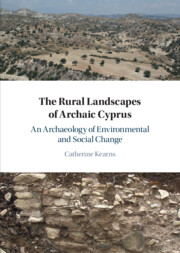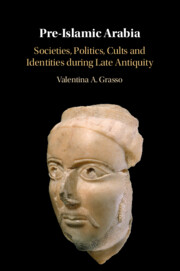Refine search
Actions for selected content:
23990 results in Ancient history
Dedication
-
- Book:
- The Senatus Consultum de Cn. Pisone Patre
- Published online:
- 10 February 2023
- Print publication:
- 23 February 2023, pp v-vi
-
- Chapter
- Export citation
Dedication
-
- Book:
- Pre-Islamic Arabia
- Published online:
- 16 February 2023
- Print publication:
- 23 February 2023, pp v-vi
-
- Chapter
- Export citation
Chapter 1 - An Introduction to the Study of Pre-Islamic Arabia
-
- Book:
- Pre-Islamic Arabia
- Published online:
- 16 February 2023
- Print publication:
- 23 February 2023, pp 1-38
-
- Chapter
-
- You have access
- HTML
- Export citation
Chapter 2 - North Arabia between the Late Third and the Fifth Century
-
- Book:
- Pre-Islamic Arabia
- Published online:
- 16 February 2023
- Print publication:
- 23 February 2023, pp 39-69
-
- Chapter
- Export citation
Index Locorum
-
- Book:
- The Attalids of Pergamon and Anatolia
- Published online:
- 02 March 2023
- Print publication:
- 23 February 2023, pp 425-432
-
- Chapter
-
- You have access
- Open access
- HTML
- Export citation

The Rural Landscapes of Archaic Cyprus
- An Archaeology of Environmental and Social Change
-
- Published online:
- 18 February 2023
- Print publication:
- 15 December 2022

Pre-Islamic Arabia
- Societies, Politics, Cults and Identities during Late Antiquity
-
- Published online:
- 16 February 2023
- Print publication:
- 23 February 2023

The Senatus Consultum de Cn. Pisone Patre
- Text, Translation, and Commentary
-
- Published online:
- 10 February 2023
- Print publication:
- 23 February 2023
22 - Terentia
- from Part IV - The Hellenistic Worlds
-
- Book:
- Women in the Ancient Mediterranean World
- Published online:
- 19 January 2023
- Print publication:
- 09 February 2023, pp 179-187
-
- Chapter
- Export citation
11 - Hatiba
- from Part II - The Bronze Age
-
- Book:
- Women in the Ancient Mediterranean World
- Published online:
- 19 January 2023
- Print publication:
- 09 February 2023, pp 102-108
-
- Chapter
- Export citation
25 - Eutychis
- from Part V - The Age of Empire
-
- Book:
- Women in the Ancient Mediterranean World
- Published online:
- 19 January 2023
- Print publication:
- 09 February 2023, pp 206-211
-
- Chapter
- Export citation
14 - Pkpupes
- from Part III - The Iron Age
-
- Book:
- Women in the Ancient Mediterranean World
- Published online:
- 19 January 2023
- Print publication:
- 09 February 2023, pp 125-131
-
- Chapter
- Export citation
Index Locorum
-
- Book:
- Athletes and Artists in the Roman Empire
- Published online:
- 02 February 2023
- Print publication:
- 09 February 2023, pp 394-395
-
- Chapter
- Export citation
Dedication
-
- Book:
- Athletes and Artists in the Roman Empire
- Published online:
- 02 February 2023
- Print publication:
- 09 February 2023, pp v-vi
-
- Chapter
- Export citation
5 - Šimatum and Kirum
- from Part II - The Bronze Age
-
- Book:
- Women in the Ancient Mediterranean World
- Published online:
- 19 January 2023
- Print publication:
- 09 February 2023, pp 62-67
-
- Chapter
- Export citation
Dedication
-
- Book:
- Women in the Ancient Mediterranean World
- Published online:
- 19 January 2023
- Print publication:
- 09 February 2023, pp v-v
-
- Chapter
- Export citation
Chapter 1 - Hellenistic Artists’ Associations
- from Part I - History
-
- Book:
- Athletes and Artists in the Roman Empire
- Published online:
- 02 February 2023
- Print publication:
- 09 February 2023, pp 19-33
-
- Chapter
- Export citation
Chapter 2 - The Emergence of the Ecumenical Synods of Competitors
- from Part I - History
-
- Book:
- Athletes and Artists in the Roman Empire
- Published online:
- 02 February 2023
- Print publication:
- 09 February 2023, pp 34-70
-
- Chapter
- Export citation
29 - Hypatia
- from Part V - The Age of Empire
-
- Book:
- Women in the Ancient Mediterranean World
- Published online:
- 19 January 2023
- Print publication:
- 09 February 2023, pp 236-242
-
- Chapter
- Export citation
23 - Mariamne
- from Part IV - The Hellenistic Worlds
-
- Book:
- Women in the Ancient Mediterranean World
- Published online:
- 19 January 2023
- Print publication:
- 09 February 2023, pp 188-194
-
- Chapter
- Export citation
